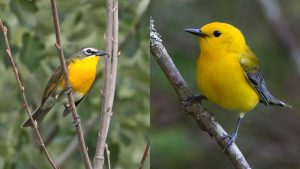Will pursuing bioenergy require trade-offs? This question served as the basis from research out of North Carolina State University (NC State) and the U.S. Geological Survey (USGS) that finds that choosing how to meet bioenergy goals means making trade-offs about the impact on ecosystems and wildlife. The study primarily focused on the southeastern U.S. but the researchers believe the results could inform global bioenergy policy.

The yellow-breasted chat (left) and prothonotary warbler (right) thrive in different habitats. Meeting bioenergy goals means making trade-offs about which wildlife species — like these — will be most impacted. Photo credit: U.S. Fish & Wildlife Service.
“Bioenergy can refer to wood pellets burned to generate electricity or to liquid biofuels, and bioenergy sources range from crops like switchgrass and sweet sorghum to cultivated pine forests and natural pine and hardwood forests,” said Nathan Tarr, lead author of one paper on the work. “There are questions about how renewable energy targets that promote bioenergy may affect wildlife habitat and forest ecosystems. We wanted to better understand the potential impacts of bioenergy demand in North Carolina and, by extension, in the Southeast and beyond.” Tarr is a research associate in the North Carolina Cooperative Fish and Wildlife Research Unit at NC State.
To address these questions, the researchers first developed models that allowed them to translate bioenergy demand into projections of changes in the size and characteristics of ecosystems. The team discovered that the specific mix of biomass sources used to meet demand could play a significant role in shaping ecosystems, especially in forests that contain high biodiversity.
“Our model results show that meeting bioenergy demand by harvesting biomass from forests retained more forest on the landscape, but the remaining forest contained less of the mature floodplain forests and longleaf pine forests that harbor biodiversity,” explained Jennifer Costanza, lead author of a second paper on the work and a research assistant professor of forestry and environmental resources at NC State. “On the other hand, using agricultural crops to meet demand reduced overall forest area, but spared more of the high-biodiversity forest land.”
Ultimately, Costanza said the biomass sources they looked at caused substantial land use change, especially in the coastal plain region – a biodiversity hotspot. Yet before completely coming to this conclusion, researchers used the projected forest changes determined in the first step to model habitat gains and losses for 16 wildlife species.- They were also able to assess what the use of different biomass sources might mean for various wildlife species.
The researchers found that realistic levels of bioenergy demand are large enough to cause large gains or losses of habitat for some species, and the specific mix of biomass sources used to meet demand resulted in trade-offs regarding wildlife habitats.
“None of the biomass sources that we looked at were good or bad for all species, nor was a single mix of biomass sources consistently the best or worst for all species,” Tarr said who added the models highlighted four general principals that need to be considered when evaluating wildlife impacts from bioenergy demand:
- Species that inhabit newly regenerating forests may benefit from bioenergy demand;
- Species that rely on a single, mature type of habitat – such as bottomland hardwood forests – are at risk if that type of habitat is harvested for bioenergy;
- Bioenergy demand could exacerbate habitat loss for species that are losing habitat to urbanization; and
- Species with small ranges deserve special consideration because they can be more sensitive to landscape changes related to bioenergy harvesting.
“This highlights the importance of setting priorities for wildlife conservation,” added Matt Rubino, co-author of the paper and a research associate in the North Carolina Cooperative Fish and Wildlife Research Unit at NC State. “Because any mix of biomass sources is likely to benefit some species and harm others, it is important to identify which species are priorities for conservation so that policies can be designed to minimize negative impacts on those species.”

